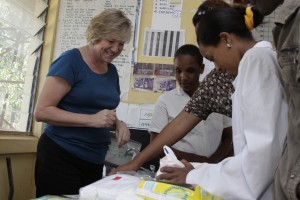Using research and data to empower the frontline

By Karen Peddicord, Association of Women’s Health, Obstetric and Neonatal Nurses (AWHONN)
If you are beyond the intersections of certain health care circles, our association name, AWHONN (the Association of Women’s Health, Obstetric and Neonatal Nurses), might not be familiar to you. But I hope you take a closer look at the tagline that accompanies our logo: “Promoting the Health of Women and Newborns.” This succinct statement underscores the core of our mission and vision. Our membership of more than 24,000 nurses represents a discipline of more than 340,000 U.S. nurses. We recognize that ensuring quality care in any country or community is, in many cases across the globe, delivered by that nurse, sometimes indeed acting alone, who lies on the frontline and might be the only hope for those patients who expect and deserve the very best care.
 2013 AWHONN President Mimi Pomerleau during a 2012 trip to Ethiopia with other members of the Frontline Health Workers Coalition. Courtesy AWHONN.
2013 AWHONN President Mimi Pomerleau during a 2012 trip to Ethiopia with other members of the Frontline Health Workers Coalition. Courtesy AWHONN.
Quality care. It requires the attention of researchers, nurses, physicians, academia, policymakers, for-profit and non-profit organizations, students, parents, patients and millions of others who must first understand the importance of the commitment to delivering quality care and then, act on providing that care. Quality care. It sounds like it should be a universal right. But the World Health Organization estimates that the risk of a woman living in a developing country dying from a pregnancy-related cause during her lifetime is about 25 times higher compared with a woman living in a developed country. The reasons that we struggle to ensure all of the world’s citizens receive equal care are complex, but I believe we can use the findings found in research and data to help move the needle forward.
The foundation for delivering evidence-based quality care may originate months or years prior, but as we consider the science of nursing and health care, we must continually employ effective research strategies so that we can increase positive outcomes at all levels, at all times possible. And the research cannot collect dust on the shelf or remain an unopened file on a laptop. We must ask ourselves: What have we learned from the data? How might this change practice? What results can we expect to discover? And then, how do we take these findings and help those on the frontline better care for their patients? In that very moment, when a nurse is monitoring a patient with postpartum hemorrhage, for example, the research has helped her determine the WHY, WHAT and HOW of treating that patient. The research results have helped the health care professional deliver better care and outcomes; ideally moving the needle forward even if ever so slightly.
And not only must we evaluate the health care environments and clinical practices themselves, we must turn the scope inward and gauge our own role in delivering care. A recent study of more than 3,000 clinicians, presented by such organizations as AWHONN, ACOG and ACNM, found that more than 90% of doctors, nurses and midwives observed colleagues demonstrating problematic behavior which they believed jeopardized patient safety. But fewer than 15% reported it. So now, what can we learn from this to help instill a higher sense of accountability to all frontline workers? Again, how can we use these data to improve care?
 AWHONN Section and Chapter leaders during an AWHONN Leadership Conference in Washington, DC, which included visits to representatives on Capitol Hill. Courtesy AWHONN.
AWHONN Section and Chapter leaders during an AWHONN Leadership Conference in Washington, DC, which included visits to representatives on Capitol Hill. Courtesy AWHONN.
We must do something with the data that are collected. This is how we can help arm the frontline. The U.S. Centers for Disease Control and Prevention (CDC)’s 2013 breastfeeding report card indicates that the percentage of U.S. infants who begin breastfeeding is rising. Of infants born in 2010, 49% were breastfeeding at 6 months, up from 35% in 2000. The breastfeeding rate at 12 months increased from 16% to 27% during that same time period. How did we move this needle? How can we leverage these data and hope to begin to see similar successes beyond the U.S. borders?
The number of both daily infant and maternal mortality rates across the globe, as reported by WHO, are jaw-dropping. In 2010 alone, about 800 women died each day due to complications of pregnancy and childbirth, including severe bleeding after childbirth, infections, hypertensive disorders and unsafe abortions. The more evidence-based research we can deliver to those on the frontline, the better our chances of reversing these alarming statistics.
As much as we’d all like to see quality care increase at an accelerated pace, we know that cultural, political and economic barriers slow us down. But together, all health care professionals, those on the frontline and those who are there in spirit must, support the practice of employing evidence-based research into practice. Research empowers those who are poised to improve the care they deliver to their patients.
